Please complete your name, email, select a question type from the list and enter your message to contact us.
Watersheds around the world are in peril and risk further decline from climate change and human impacts, like pollution, degrading landscapes, and unsustainable water use. These impacts can inhibit the ability of ecosystems to regulate water flows, sequester carbon to reduce atmospheric greenhouse gas levels, maintain biodiversity and healthy waterways, promote social well-being, offer economic opportunities, and sustain agricultural productivity. Climate change is exacerbating these impacts by shifting weather and precipitation patterns, degrading habitats, and increasing the recurrence and severity of natural disasters. Urgent action is needed to address these impacts by implementing nature-based solutions (NBS).
NBS protect, sustainably manage, and restore natural or modified watersheds, to address societal challenges effectively and adaptively, simultaneously providing human well-being and biodiversity benefits (IUCN, 2016). Investment in NBS offers a mechanism to restore degraded watersheds and protect intact ones, leading to improved water quality and quantity, improved carbon sequestration and increased biodiversity, among many other social and economic benefits. NBS also support climate mitigation and adaptation efforts and reduce the impacts from other shocks, such as floods, droughts, and extreme weather events. Implementing NBS can also help advance progress toward achieving the United Nations Sustainable Development Goals (SDGs), particularly SDG 2 (zero hunger), SDG 6 (water), SDG 11 (sustainable cities and communities), SDG 13 (climate action), and SDG 15 (life on land). NBS therefore support social, economic and environmental objectives, and may be particularly important in supporting vulnerable communities.
While investment in NBS has grown significantly over the last decade, several barriers hinder widespread implementation. A key gap is the lack of a standardized method to identify, account for, and value the numerous benefits of NBS. To address this, the project team, comprising the Pacific Institute, CEO Water Mandate, Danone, The Nature Conservancy and LimnoTech, are working to demonstrate how identifying and accounting for stacked benefits can help build the case for investments in NBS for watersheds. The outcomes and outputs from this project support public, private and non-profit sectors in supporting and/or developing effective policies, programs, and projects to incentivize greater implementation of and investment in NBS.
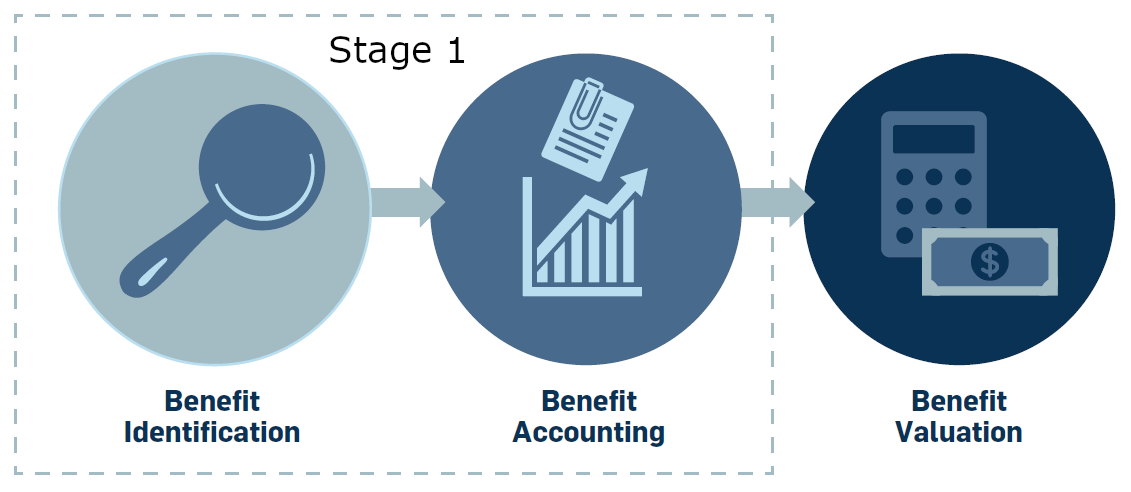
Stage 1: Launched in January 2020, Stage 1 of the project addressed the need for a standardized method and guidance, based on the outcomes from the project’s initial Landscape Assessment. This work focused on Benefit Identification and Accounting (Figure 1). A practical guide was developed through extensive stakeholder engagement and provides a method for identifying and estimating NBS benefits. This method has been compared to the outcomes and outputs of real-world NBS projects around the world and aligns closely with these case studies. Components of this stage have been developed into a user-friendly tool that will allow users to identify and account for benefits across multiple habitats and interventions.
The Benefit Accounting of Nature-Based Solutions for Watersheds project has produced several key outputs:
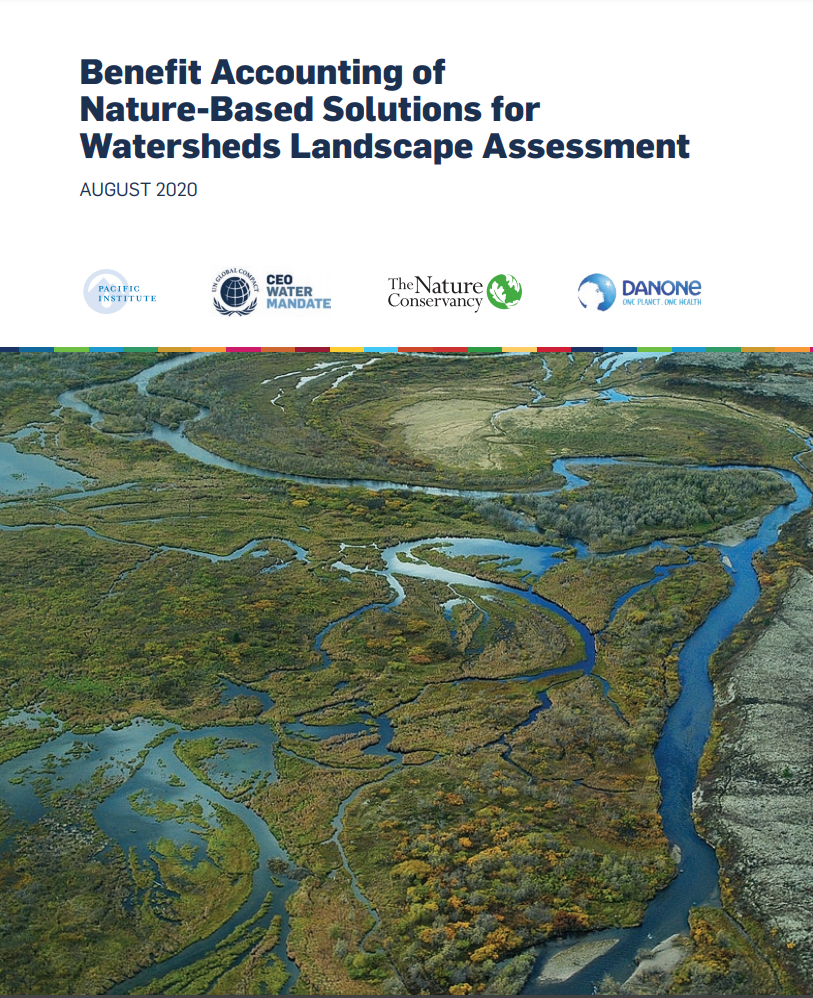
The landscape assessment was undertaken to inform the path forward for engaging the private sector to invest in NBS. A literature review was undertaken to understand the contemporary thinking around NBS and identify key opportunities and challenges faced by decision makers, practitioners, and researchers. Interviews conducted with businesses, civil society, and academia who have already implemented NBS project or are looking to do so yielded qualitative responses to complement or contrast the findings from the literature review. A review of NBS case studies from the private sector was also conducted.
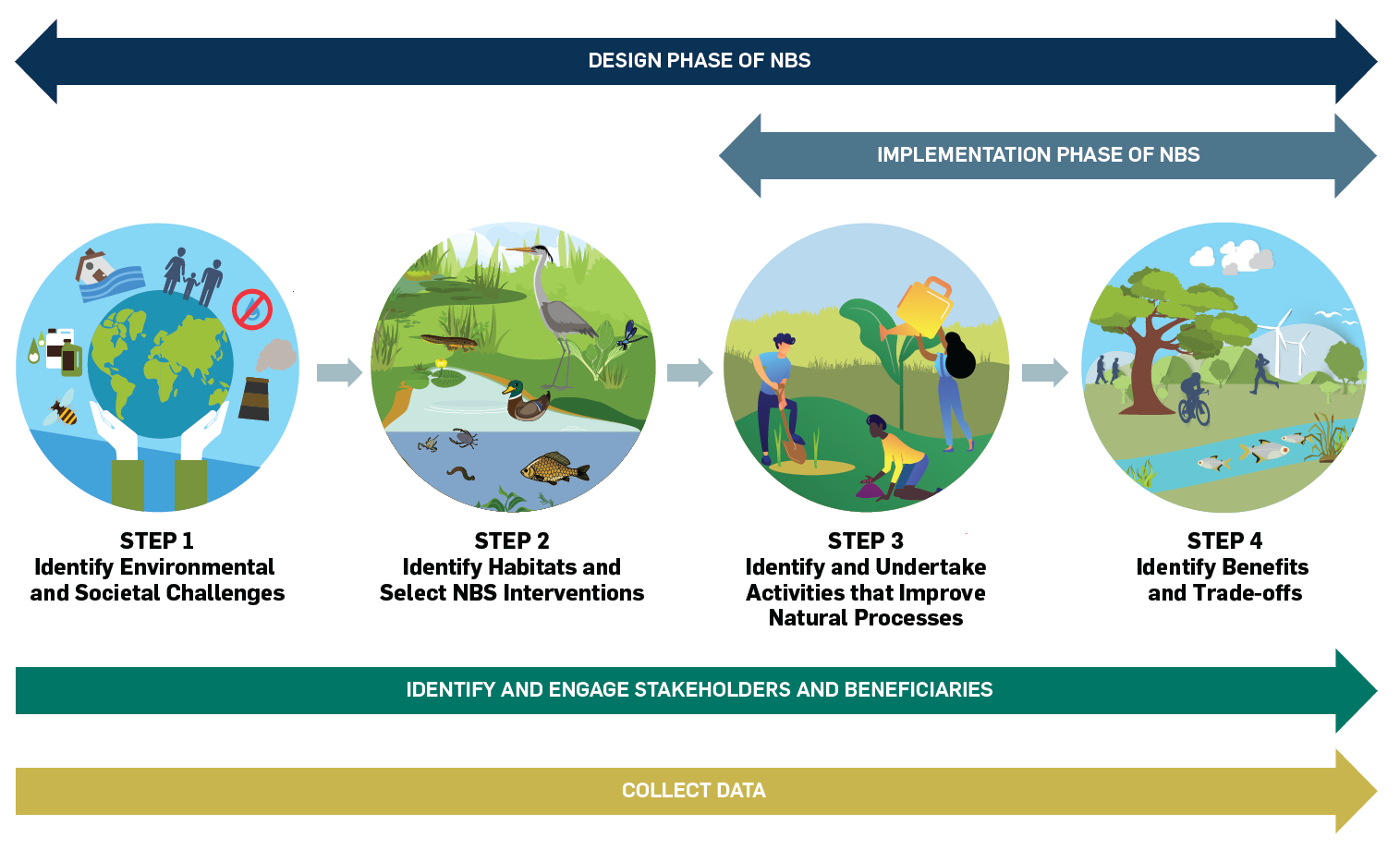
This project developed a method to account for the stacked water, carbon, biodiversity, and socio-economic benefits of NBS for watersheds. This method is designed to align with existing tools and resources for NBS benefit accounting and incorporate lessons learned from NBS case studies globally.
By promoting the quantification of stacked benefits of NBS, this method can help to:
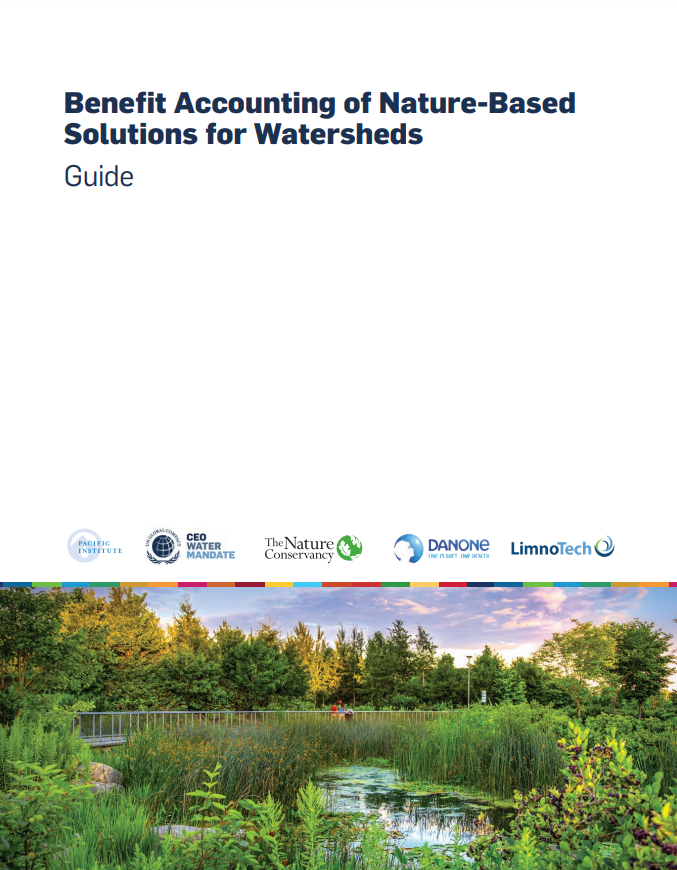
This guide was written to help organizations and individuals to identify (using the method developed) and account for the multiple benefits accruing from NBS investments. The guide indicates which specific NBS activities can be implemented in various habitats and suggests methods for estimating and measuring the benefits. Refer to Tables 5-9 in Section 3 of the guide for a summary of benefits and associated activities, indicators, and calculation methods.
Accounting for NBS benefits will improve a company’s impact monitoring and help build the business case for these “green” solutions, thereby supporting widespread implementation. Specifically, the guide helps users account for and measure the stacked water, carbon, and biodiversity benefits, as well as additional socio-economic benefits. The aim of this work is to increase the overall awareness of the value of NBS and increase investments in NBS, not only for ecosystem health and community development, but also for businesses and other stakeholders directly
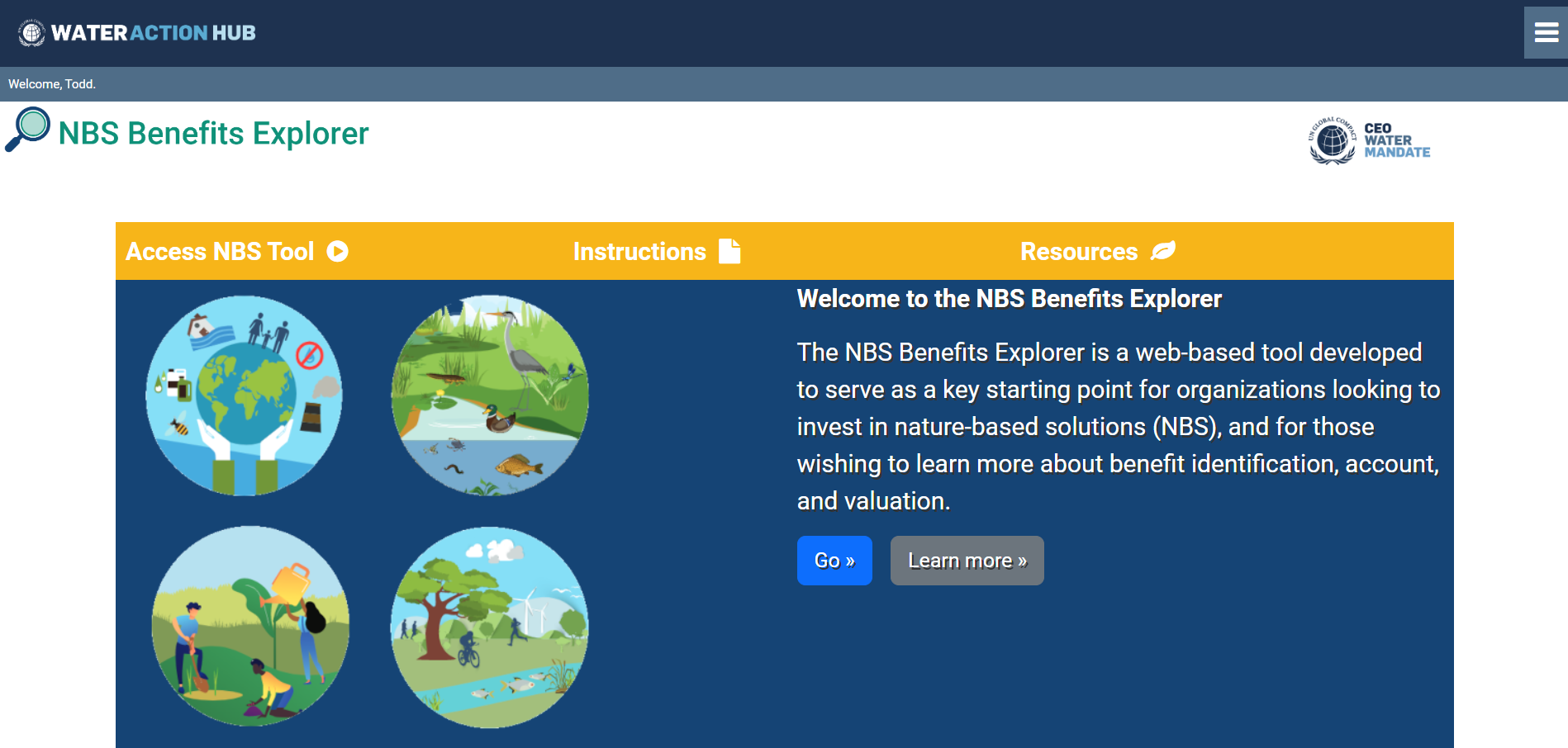
The final product of this work is an online tool, the NBS Benefits Explorer, which adopts the developed method to identify and account for NBS benefits. Users of this tool will be able to select multiple habitat and intervention types to receive associated activity, process, and benefit outcomes. Benefits can be identified and accounted for across water quantity, water quality, carbon, biodiversity and the environment, and socio-economic themes.
The dynamic tool is highly intuitive and user friendly and will also inform the user of additional methods and approaches to further quantify the benefits identified. The tool is a key starting point for organizations looking to invest in NBS, or for those wishing to learn more about benefit identification and accounting. The tool will be updated to include further outcomes and outputs of this work.
American Enterprise Institute. (2020). Land Price and Land Share Indicators.
Alliance for Water Stewardship. (2017). International Water Stewardship Standard.
Arscott, D. and others. (2020). Estimating the Influence of Land Protection on Water Quality. DRAFT report prepared for the Open Space Institute.
Booth, B.D., Murphy, S.D., and Swanton, C.J. (2003). Weed ecology in Natural and Agricultural Systems. Wallingford CT: CABI Publishing.
Brill, Gregg, Tien Shiao, Cora Kammeyer, Sarah Diringer, Kari Vigerstol, Naabia Ofosu-Amaah, Michael Matosich, Carla Müller-Zantop, Wendy Larson and Tim Dekker (2021). Benefit Accounting of Nature-Based Solutions for Watersheds: Guide. United Nations CEO Water Mandate and Pacific Institute. Oakland, California.
Delaplane, Keith S. and others. (2013). Standard methods for pollination research with Apis mellifera. Journal of Apicultural Research, 52(4): 1-28.
Diringer, S. and others (2020). Incorporating Multiple Benefits into Water Projects: A Guide for Water Managers. Oakland, CA: Pacific Institute.
Donatti, C.I. and others. (2020). Indicators to measure the climate change adaptation outcomes of ecosystem-based adaptation. Climatic Change 158: 413–433.
Fanchi, J.R. (2010). Integrated Reservoir Asset Management. Gulf Professional Publishing. Pages 17-32, ISBN 9780123820884.
Food and Agriculture Organization of the United Nations (2017a). The Food Insecurity Experience Scale: Measuring food insecurity through people’s experiences.
Deutsche Gesellschaft für Internationale Zusammenarbeit (GIZ) (2015). Repository of Adaptation Indicators Real case examples from national Monitoring and Evaluation Systems.
Hilty, J., Worboys, G., Keeley, A., Woodley, S., Lausche, B., Locke, H., Carr, M., Pulsford, I., Pittock, J., White, J.W., Theobald, D., Levine, J., Reuling, M., Watson, J., Ament, R., and Tabor, G. (2020). Guidelines for conserving connectivity through ecological networks and corridors.
Hirschman, David J. and others (2018). Updating the Runoff Reduction Method. Prepared for Metro Government of Nashville and Davidson County Tennessee Metro Water Services, Stormwater Division.
Kazemi, Fatemeh, Simon Beecham and Joan Gibbs (2011). Streetscape Biodiversity and the Role of Bioretention Swales in an Australian Urban Environment. Landscape and Urban Planning 101(2): 139-148.
Imhoff, M., Zhang, P., Wolfe, R., and Bounoua, L. (2010). Remote sensing of the urban heat island effect across biomes in the continental USA. Remote Sensing of Environment. 114. 504-513.
Intergovernmental Panel on Climate Change (2006). IPCC Guidelines for National Greenhouse Gas Inventories.
International Union for Conservation of Nature (2012). Habitats Classification Scheme (Version 3.1). Cambridge: IUCN Global Species Programme Red List Unit.
International Union for Conservation of Nature (2016). Resolution 69 on Defining Nature-based Solutions (WCC-2016-Res-069). IUCN Resolutions, Recommendations and Other Decisions. 6-10 September 2016. World Conservation Congress Honolulu, Hawai‘i, USA.
Le Maitre, David C. and others (2020). Impacts of Plant Invasions on Terrestrial Water Flows in South Africa. Biological Invasions in South Africa. Invading Nature - Springer Series in Invasion Ecology, vol 14. Springer, Cham.
MacKinnon Kathy and others (2019). Nature-Based Solutions and Protected Areas to Improve Urban Biodiversity and Health. Biodiversity and Health in the Face of Climate Change. Springer, Cham.
Neitsch, Susan L. and others (2011). Soil and Water Assessment Tool Theoretical Documentation Version 2009. Texas Water Resources Institute.
New Hampshire Department of Environmental Services (2008). New Hampshire Stormwater Manual Volume 1. Stormwater and Antidegradation.
Noble, Ian R. and others (2014). “Adaptation needs and options.” In: Climate Change 2014: Impacts, Adaptation, and Vulnerability. Part A: Global and Sectoral Aspects. Contribution of Working Group II to the Fifth Assessment Report of the Intergovernmental Panel on Climate Change. Field, C.B. and others, eds. Cambridge University Press, Cambridge, United Kingdom and New York, NY, USA. Pp. 833-868.
Reig, Paul and others (2019). Volumetric Water Benefit Accounting (VWBA): A Method for Implementing and Valuing Water Stewardship Activities. Working Paper. Washington, DC: World Resources Institute.
Schueler, Thomas R. (1987). Controlling urban runoff: a practical manual for planning and designing urban BMPs. Washington, DC: Metropolitan Washington Council of Governments.
Shiao, Tien and others (2020). Benefit Accounting of Nature-Based Solutions for Watersheds Landscape Assessment. Oakland, CA. United Nations CEO Water Mandate and Pacific Institute.
Smullen, James T., Amy L. Shallcross and Kelly A. Cave (1998). Updating the U.S. Nationwide Urban Runoff Quality Database. 3rd International Conference on Diffuse Pollution: August 31 - September 4, 1998. Edinburg, Scotland: Scottish Environment Protection Agency.
Sweeney, Bernard W. and J. Denis Newbold (2014). Streamside Forest Buffer Width Needed to Protect Stream Water Quality, Habitat, and Organisms: A Literature Review. Journal of the American Water Resources Association. Paper No. JAWRA‐13‐0102‐P.
United States Environmental Protection Agency (1982). Water Quality Assessment: A Screening Procedure for Toxic and Conventional Pollutants. Part 1. Environmental Research Laboratory, Athens, GA.
University of Oxford (2019). Nature-Based Solutions Initiative. Oxford: University of Oxford Department of Zoology.
Wischmeier, Walter H. and Dwight D. Smith (1978). Predicting Rainfall Erosion Losses: A Guide to Conservation Planning. Agriculture Handbook No. 537. Washington, DC: USDA/Science and Education Administration, US. Govt. Printing Office.